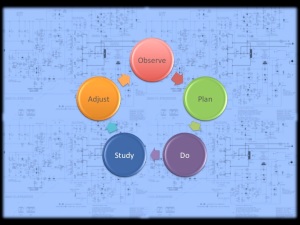by Ryan D. Bretsch
‘It is a capital mistake to theorize before one has data. Insensibly one begins to twist facts to suit theories, instead of theories to suit facts.” — Sherlock Holmes
APPYLING DEMING-BASED PRINCIPLES TO SALES OPERATIONS
What is an Sales OPDSA Planning Process?
The derivative Sales OPDSA is a variation of a W. Edwards Deming designed management methodology (PDSA) used to ensure quality in the planning and decision-making process. It is particularly focused on providing continuity, direction, alignment and organization when designing and planning the improvement of sales operations processes. OPDSA is a universally validated, scientific method/approach to business process design because it applies a disciplined, systematic and rigored approach to solving complex sales operations issues.
In a business world where “3 Easy Ways to Increase Sales” or “How to Do $10M in Sales on Shoestring Budget” is the new normal, the concept of planning and applying the proper resources to business execution may seem almost old-fashioned. Interestingly enough, however, the difference between the 80% of new businesses that fail and the 20% that succeed is oftentimes having a well-defined plan and getting clean execution on it versus the fashionable but dangerous mantra of “just do it”. That works for Nike, but guess what? It is not a practical application for accomplishing standard business objectives.
So let’s talk about effective planning. And let’s talk about applying Deming to the sales operations world.
The components of the Sales OPCSA (a derivative of the Deming PDSA cycle) are as follows:
OBSERVATION
In Deming Circles, observation is ascribed to “grasp the current condition”. In other words, this means taking the time to record the state of affairs in sales operations as it exists currently. Observation incorporates working to understand and document any inefficiencies and challenges presented by the current method of accomplishing work/selling goals. Determine what needs to be measured and reviewed.
PLAN
Before we even begin talking about planning, I want to emphasize an important note: The executive team must be “aligned” to pursue planning objectives. Don’t assume “alignment” exists. It is one of the largest mistakes an executive team can make for gaining swift business execution further down the road. Test for it. Planning involves identifying and establishing the objectives and processes necessary to deliver sales results in accordance with the expected sales targets and goals.
- Analyze the previously observed “current situation” by reviewing all associated data. Identify both positive and negative outcomes along with their associated causes. Rank their importance and set priorities for action.
- Define the criteria for measuring data (key performance measurements) related to the sales operation; in advance of further assessment.
- Establish specific objectives and successful “outcomes” for what needs to be accomplished.
- Create the plan. Document an ordered process for taking action, with specific agreements and responsibilities defined, agreed upon and then assigned.
- Document and resolve, through planning, any expected barriers to implementation.
- Document the concrete steps needed for execution, with the associated timeline for accomplishing specific objectives.
- Common tools to use in the PLAN stage for analyzing data inputs are Histograms, Correlation Analysis, Pareto Charts and Cause/Effect Diagramming.
DO
Implementation phase. Execute the agreed upon sales operations process/plan. Responsibility for execution and resultant accountability rests solely where it has been previously assigned. There should be no overlap or interference of responsibility, engagement or assignment. Collect data for documentation — to provide further analysis for the next steps.
STUDY (CHECK)
Study the actual results of implementation and the manner in which the plan was executed. Verify that the execution phase was carried out on schedule and executive staff completed all assigned responsibilities. Compare the “actual” results of execution against “expected” results to ascertain what the differences are and why they occurred. Review to ensure the plan was realistic to implement by listing actual barriers to implementation. Finally, look at deviation in the execution of plan by assigned responsibility and determine reasons for deviation. Assess to ensure any deviation from the agreed upon plan was for valid reasons.
ADJUST (ACT)
Adjust the plan as needed, to reconcile the difference between the new current state and the desired state, as previously outlined in the planning objectives. Request corrective actions on significant differences between actual and planned results. Analyze relevant differences to determine their root causes. Determine where to apply changes which will improve the process. Implement these changes.

